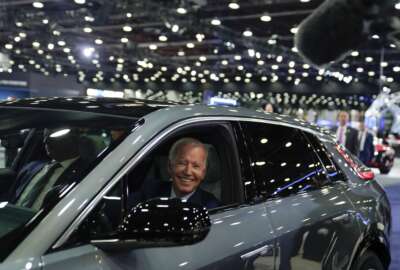Federal agencies saving $2B annually under green-government goals, Biden administration says
Federal agencies are buying electric vehicles at a higher rate than the general public.
The federal government is on track to meet some of the Biden administration’s upcoming sustainability goals — and cutting costs in the process, according to administration officials.
An official from the White House Council on Environmental Quality (CEQ) told Federal News Network on Monday that the federal government saved about $20 billion through energy savings performance and efficiency initiatives over the past two decades.
The official said that in recent years, that translates into about $2 billion in annual cost savings.
President Joe Biden, as part of an executive order he signed three years ago, expects agencies to reach net-zero greenhouse gas emissions across all federal operations by 2050, including a 65% reduction by 2030.
The CEQ official said the federal government is “decidedly on track” to meet those goals.
The official added that, at the current rate of progress, agencies would achieve a 70% reduction in greenhouse gas emissions by 2030 — surpassing the administration’s targets. Federal agencies have seen a 40% reduction of greenhouse gasses, compared to a 2008 baseline.
Under the Biden administration, the federal government invested $12 billion and launched thousands of sustainability projects. They include transitioning the federal government to electric vehicles, investing in sustainable construction materials and making federal buildings more energy efficient.
Federal agencies under the Biden administration ordered nearly 82,000 zero-emission vehicles and installed 10,500 charging ports at federal facilities nationwide. Another 52,500 charging ports are in the process of being installed.
All told, electric vehicles now make up about 13% of the total federal fleet. The CEQ official said zero-emission vehicles made up about 20% of the federal government’s light-duty vehicle purchases this year — up from 2% in the Biden administration’s first year.
Federal agencies, at this rate, are buying electric vehicles at a higher rate than the general public. Electric vehicles now account for about 10% of all consumer vehicle sales.
The Postal Service’s plans for a majority-electric next-generation delivery vehicle fleet are driving much of the federal government’s sustainable fleet progress. USPS owns about 240,000 vehicles, which accounts for about a third of the total federal fleet.
USPS is taking steps to ensure at least 75% of its next-generation delivery vehicle fleet will be electric in the coming years and will purchase 100% electric NGDVs starting in 2026.
USPS is spending about $10 billion on its new fleet, but Congress gave the agency $3 billion in the Inflation Reduction Act to buy more electric vehicles and charging stations than it could otherwise afford.
The incoming Trump administration, however, may complicate these plans. Reuters first reported that President-elect Donald Trump is considering canceling the Postal Service’s electric vehicle contract.
It’s not entirely clear how the Trump administration could require USPS, an independent and generally self-funded federal agency, to modify its strategy midway through its fleet acquisition plans.
USPS in February 2021 awarded a multiyear contract to vendor Oshkosh Defense to manufacture gasoline-powered and electric versions of its new, custom-built Next Generation Delivery Vehicle. In addition, the agency is also purchasing commercially available electric vehicles.
The CEQ official stressed that USPS, in Inflation Reduction Act negotiations, independently chose to lead the federal government’s fleet electrification efforts.
Postmaster General Louis DeJoy told Bloomberg in an interview last Friday that he hadn’t had any communication from the Trump team on the possibility of unwinding the Postal Service’s electric-vehicle contracts, and declined to comment further. A USPS spokesperson declined to comment Monday.
The CEQ official said agencies that have received direct appropriations have been “generally off to the races” when it comes to purchasing electric vehicles and EV chargers. However, the official said several agencies are also working within their current operating budgets to meet the administration’s EV goals.
Federal employees are also doing their part to reduce greenhouse gas emissions.
The Biden administration last year directed the federal workforce to prioritize the use of sustainable transportation, including electric vehicles, for official and local travel.
The Office of Management and Budget, in a memo last year, directed agencies to prioritize sustainable options for official travel. That includes driving electric vehicles instead of gas-powered cars, choosing commuter rail over flights and long-distance drives, and opting for public transit over driving.
The General Services Administration, in its own guidance, encouraged federal employees in some cases to consider virtually attending some meetings and conferences, rather than going in person.
The CEQ official said that, generally speaking, fewer federal employees in the D.C. metro area are flying to New York for official travel, and instead taking commuter rail options, such as Amtrak.
The federal government spends nearly $3 billion a year on official travel, which covers nearly 3 million flights and more than 2 million car rentals.
The Biden administration has also taken steps to make federal buildings more energy efficient. The White House estimates more than 2,700 net-zero emission projects are either complete or underway across the federal government’s real estate portfolio.
Copyright © 2025 Federal News Network. All rights reserved. This website is not intended for users located within the European Economic Area.
Jory Heckman is a reporter at Federal News Network covering U.S. Postal Service, IRS, big data and technology issues.
Follow @jheckmanWFED






